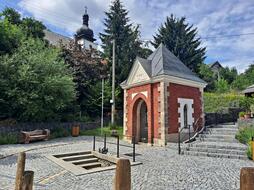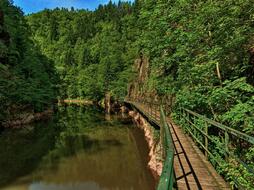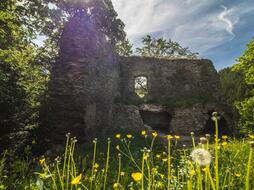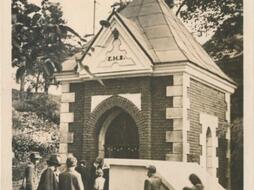Village of Bozkov

Bozkov is situated in the foothills of the Giant Mountains, 8 kilometres to the north of the towns of Semily, Železný Brod and Vysoké nad Jizerou. Its borders are formed by the Kamenice river and the Vošmenda stream.
The inhabitants of Bozkov traditionally used to make their living farming and processing flax, and the abundance of iron ore also attracted miners from the Middle Ages. The village is also famous for its pilgrimages to the Virgin Mary and, more recently, Bozkov Dolomite Caves.
Bozkov not only has a rich history and a wealth of cultural and natural heritage sites, but its position and amenities also make it ideal for a stay lasting a number of days. It hosts cultural and sporting events and has also plenty to offer for families with children.
History of Bozkov
The first record of the village in the written sources dates back to around 1360, when the Cistercians from Klášter nad Jizerou near Mnichovo Hradiště sold it to Hašek Zvířetický of Lemberk, the holder of the Semily estate, of which it remained part.
The inhabitants of Bozkov made their living farming and processing flax. The abundance of iron ore has attracted miners and hammer mill workers since the Middle Ages. Iron was found along the Vošmenda stream from mediaeval times, attracting miners and hammer mill workers. The mining village of Betkovice sprang up by the Vošmenda; it is now known as Dolní Bozkov or Podbozkov. In the 19th and 20th centuries Bozkov saw the emergence of glass grinding mills, a weaving mill, a coffee grinder factory and other businesses that provided the local inhabitants with a livelihood. The village was also made famous by Marian pilgrimages to the Virgin Mary of Bozkov, also known as the Queen of the Mountains, and in more recent times the Bozkov Dolomite Caves. In 1923, Bozkov was elevated to the status of a township.
Noteworthy sights include the Baroque Church of the Visitation of the Virgin Mary (1690–1693) with its viewing walkway on the tower, as well as the Sejkora Chapel with its valuable folk-style sculpture of the Pietà, and the “U Matičky” spring, said to have healing powers. There are a number of fine listed examples of folk architecture in the village.
The hiking trail markers take you to Semily (yellow), Vysoké nad Jizerou (blue), Bohuňovsko (green, blue) and Jesenný. Biking trail 1074 runs through the village from Semily to Vysoké.
What to visit in Bozkov?
CHURCH OF THE VISITATION OF THE VIRGIN MARY
The majestic Church of the Visitation of the Virgin Mary dates back to 1693. It was built at the instigation of Countess Marie Polyxena Desfours, at that time the owner of the estate, back when the older church no longer proved adequate for the pilgrims who came to see the statue of the Virgin Mary of Bozkov, also known as the Queen of the Mountains. The church tower is 49 metres high and is open to the public.
School lessons began to be held in Bozkov in 1749. In 1773 the village and the parish priest went halves to buy the cottage at no. 40 as permanent premises for the school and “for the betterment of the teachers”. A new school was built in its place in 1786, which the children still attend classes in today.
DŘEVĚNKA BOZKOV
The house with a farm was built in 1752. It has been owned by the Farský and Balatka families since the mid-19th century and now houses a restaurant and a guest house. The Dřevěnka was listed as a cultural heritage site in 2011.
U MATIČKY CHAPEL
In 1900, the village had a chapel built on the site where a spring of tasty water, said to have healing powers, had gushed forth since time immemorial, and a statue of the Virgin Mary was moved there from the former cemetery chapel. The shady area around it is a lovely place to relax.
PODBOZKOV
Dolní Bozkov, also known as Podbozkov, is a district of Bozkov situated in the valley of the Vošmenda stream. Iron was mined here in the Middle Ages, iron hammer mills were built, and the area was settled by hammer mill workers from Germany. Nowadays there is a crossroads in Podbozkov, with routes leading to the centre of Bozkov and towards Železný Brod, Příkrý, Vysoké nad Jizerou and Semily.
SEJKORA CHAPEL AND MASARYK VIEWPOINT
The niche chapel of Our Lady of Sorrows dating from 1693 is located in the village of Cimbál on the boundary of the cadastres of Semily and Bozkov (the yellow footpath markers towards Semily). The chapel was twice visited by T. G. Masaryk, which is why the nearby viewpoint, from which the first Czechoslovak president admired the view of Bozkov, the Giant Mountains and Kozákov, is named after him.
The deeply cut valley of the Kamenice River is ideal for hiking and you can walk through it along the Palacký Trail, opened in 1912. It leads from the confluence with the Jizera in Podspálov and continues below the ruined castle of Návarov as far as Tanvald.
BOZKOV DOLOMITE CAVES
Bozkov Dolomite Caves, declared a national natural monument in 1999, are visited by around 70 thousand people a year from all over the world. The tour of the caves is not a physically strenuous one and even smaller children will have no difficulties completing it. At over a thousand metres long, this is the largest known cave system in north-eastern Bohemia. The caves are famous for their impressive stalagmites and stalactites, and for containing the biggest underground lagoon in Bohemia.
VOŠMENDA VALLEY NATURE TRAIL
This circular trail starts at the car park in Bozkov and leads through the Vošmenda Valley nature reserve. It follow the blue footpath markers first, and then the green ones. The eleven stops along the trail provide information on the local nature reserve, the landscape of the Podkrkonoší region, iron ore mining, the lime industry, karst phenomena and protected flora and fauna.
U BOROVICE LOOKOUT TOWER
This square lookout tower above the village of Roprachtice was opened on 17th November 2009. There are 70 steps leading up to the wooden walkway, which was built by Mr Pacholík, a local carpenter. From the top there are beautiful panoramic views of the Jizera Mountains, Ještěd, the Giant Mountains, the Eagle Mountains, the peaks of Tábor, Bezděz, Milešovka and Ralsko, and down into the valleys of the Jizera and Kamenice rivers.
PODSPÁLOV and THE RIEGER TRAIL
Podspálov is situated at the confluence of the Jizera and Kamenice rivers. Three major hiking trails meet at the railway station there – the Palacký Trail along the Kamenice, the Rieger Trail along the Jizera and the Kamenice Trail leading across the upper edge of the valley to Semily. There is also a hydroelectric power station there, built in 1921 and designed by the famous architect Emil Králíček, which is still fully operational today.
The Rieger Trail runs for 3.5 kilometres from Podspálov to Semily. The route passes through the romantic Jizera valley and the rocky canyon known as the Jizera Gallery. The trail is named after the renowned doctor František Ladislav Rieger, who was born in Semily.
Podbozkov
Besides some beautiful natural scenery, the valley of the Vošmenda also contains some quaint folk architecture, such a former mill and various dwellings that have still retained their original character. There is also a water treatment plant in the valley that supplies drinking water to the surrounding towns and villages, especially Semily, Benešov u Semil and Chuchelna, which are roughly eight kilometres away. On the hill opposite the bus shelter, you can see a former sheepfold. Back then, the herds of sheep that grazed the flowering meadows around further accentuated the beauty of this picturesque valley.
The history of Podbozkov is closely linked to the aforementioned Vošmenda stream. There was an abundance of iron ore along its course, which attracted miners and hammer mill workers during mediaeval times. According to some sources, the history of mining here dates back to 1080, when Benedictine monks built a small castle on the wooded hill to the left of the former sheepfold building, and below it in the valley they founded a settlement called Bedkovice, whose inhabitants were supposedly miners. The little castle above Bedkovice was destroyed during later wars, although part of the village of Bozkov is still called “Na Hrádku” (“At the Little Castle”). Bedkovice is last mentioned in the parish records in 1657 in connection with the payment of the compulsory tithe.













